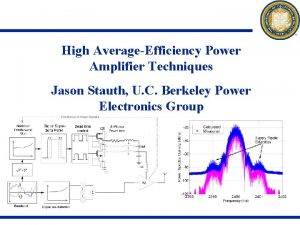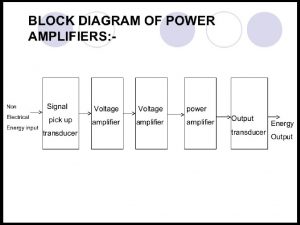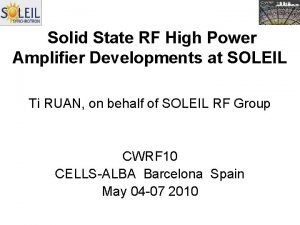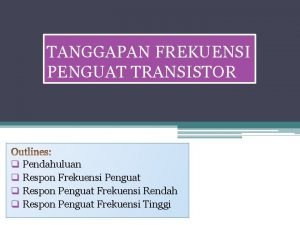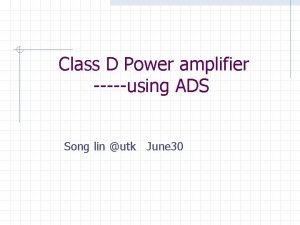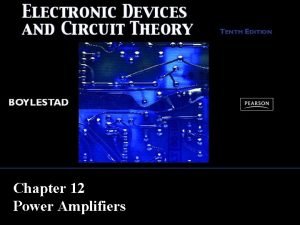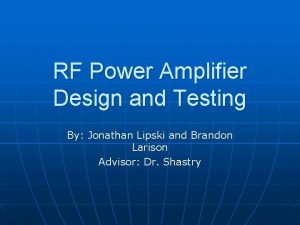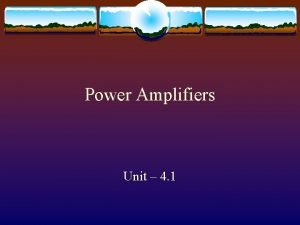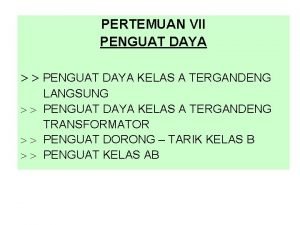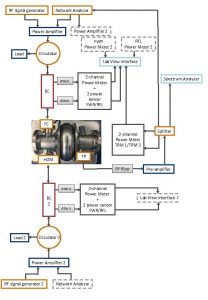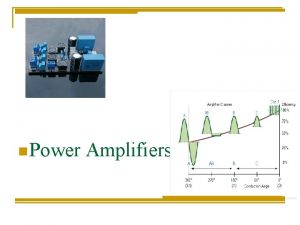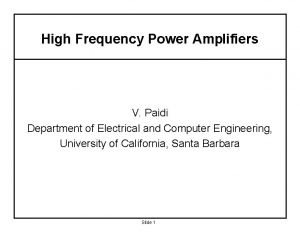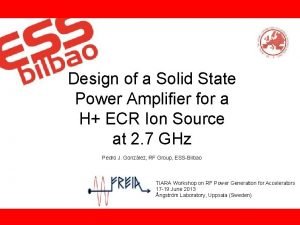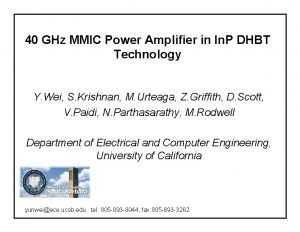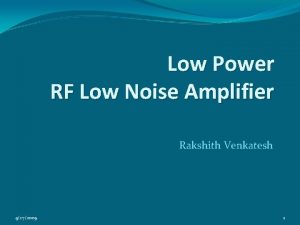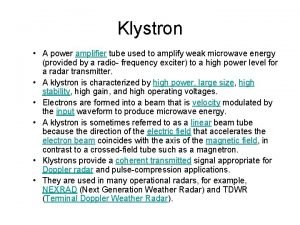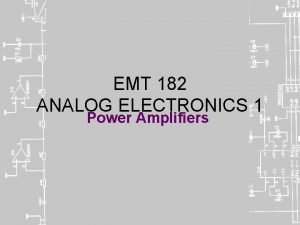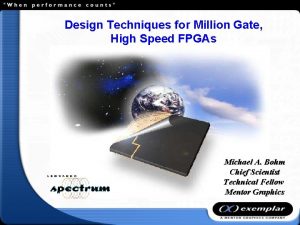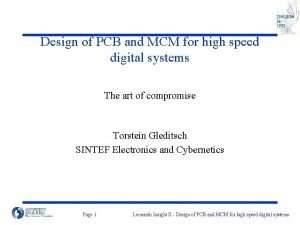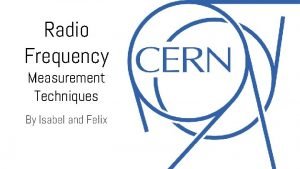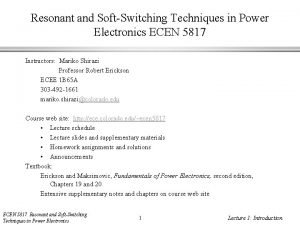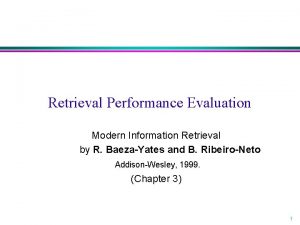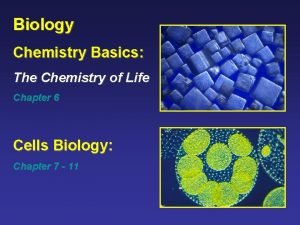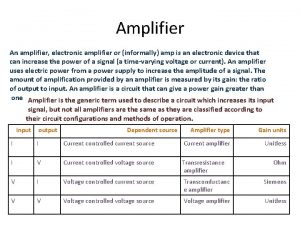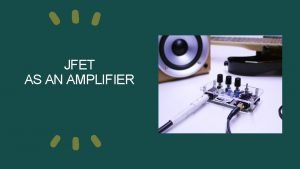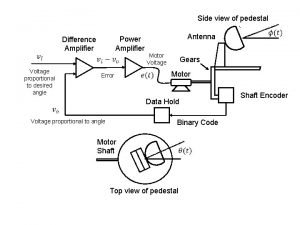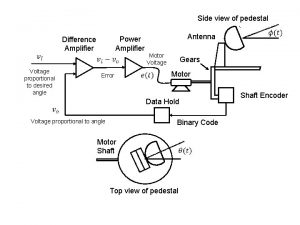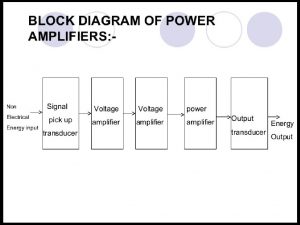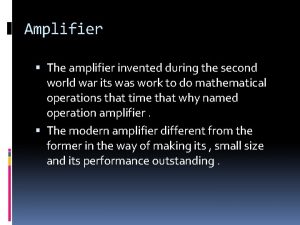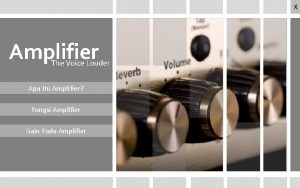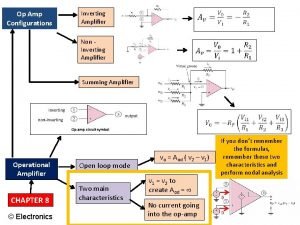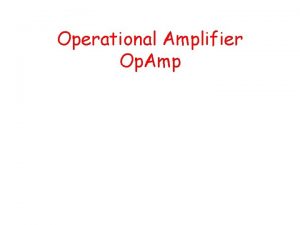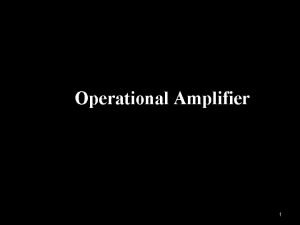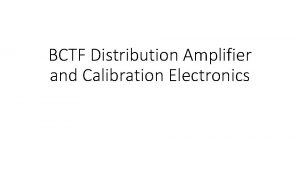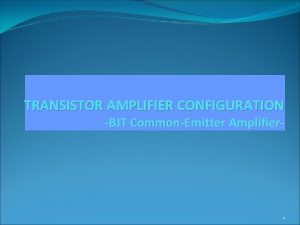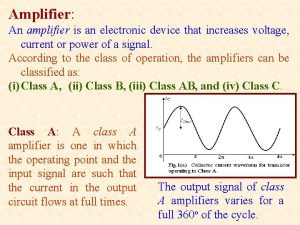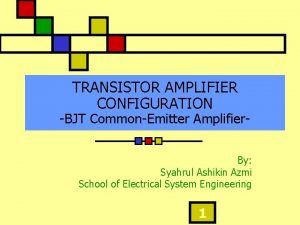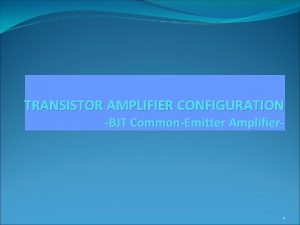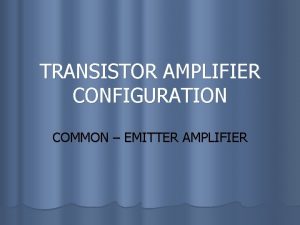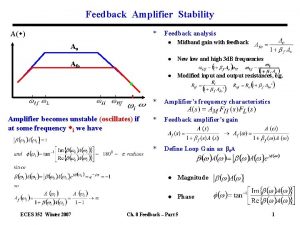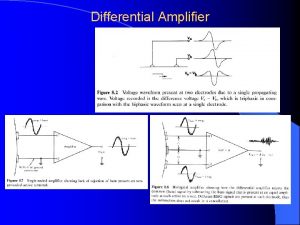High AverageEfficiency Power Amplifier Techniques Jason Stauth U











































![References • • • [1] A. Jerng and C. G. Sodini, "A Wideband Delta-Sigma References • • • [1] A. Jerng and C. G. Sodini, "A Wideband Delta-Sigma](https://slidetodoc.com/presentation_image/4ce9a8e411d42aae6e45f7f09074f287/image-44.jpg)
- Slides: 44

High Average-Efficiency Power Amplifier Techniques Jason Stauth, U. C. Berkeley Power Electronics Group

Overview • Application Space: Efficient RF Power Amplifiers • PA Fundamentals, Polar/ET Architectures • Challenges with Polar/ET • Research Directions • Direct Digital Modulation • Pulse-Density Modulation

Power Amplifier Fundamentals Q I Edge Constellation: 3 pi/8, rotated 8 -PSK

Linear Power Amplifier (PA) • Active transconductance device • Input matched to previous stage • Output (antenna) impedance transformed to increase power gain • Small-signal model close to common source amplifier

• Active device operates as a switch • Approx LTV System • Voltage waveform constrained (also consider current waveform) Drain Voltage Nonlinear PA constrained unconstrained Gate Voltage -Class E/F ZVS Amplifiers, Kee et al. , MTT ‘ 03 • Class-F — Frequency Domain — Impedance Design • Class-E — Time domain — Impulse Response design

The Point… • Nonlinear PAs can’t do amplitude modulation • Linear PAs can do amplitude modulation, but are inefficient

Average Efficiency PA Class: Class A Average Efficiency: 0. 78%* / 9. 2%** Class B 14. 46% Nonlinear PA *constant bias current 18. 21% **variable bias current

Polar and Envelope Tracking Transmitters • Supply regulation synchronous with RF Envelope -Raab et al. “High efficiency L-band Kahntechnique transmitter, " MTT-S, 1998. -Hanington, et al. "High-Efficiency Power Amplifier Using Dynamic Power-Supply Voltage for CDMA Applications, " MTT, Aug. 1999.

Polar Architecture Q I • • Many (most? ) implementations don’t use an efficient supply modulator efficiency gains from using nonlinear PA

Envelope Tracking • Linear (class-AB) PA • Efficient supply modulator (linear reg doesn’t make sense) Operate at max PAE point

Challenges • • • Bandwidth Peak-average power ratio Time alignment Distortion (AM-AM, AM-PM) PSRR

Project Directions Wideband Switching Regulators Hybrid Linear. Switching Regulators Direct Nonlinear Modulation Transmitters

Wideband Switching Regulators • • Envelope Tracking Architecture Wideband: 20 MHz Envelope bandwidth High switching frequency High PSRR PA

Challenge: Power Supply Rejection • Supply noise can mix into the RF spectrum, degrading SNR, violating spectral masks (ACPR) • New Concept: design for high PSRR -Stauth, Sanders, "Power supply rejection for RF amplifiers, " (RFIC) Symposium, June 2006

Results: MTT Oct ‘ 07 • Supply-Signal mixing term: PSRR=sideband in d. Bc for 1 V (0 d. Bv) supply noise tone

Hybrid Linear-Switching Regulators

Hybrid Regulator Paradigm Series Hybrid Parallel (shunt) Hybrid • Decouple bandwidth-efficiency (audio, AVS digital, PA supply) • Fast linear block: (supply dynamic output voltage, attenuate switching regulator harmonics) • Slow switching block: (efficient, low cost) • Series hybrid drawbacks: low Vdd efficiency, headroom issues

Parallel Hybrid Operation • Linear Stage: Voltage Follower (Class AB LDO) • Switching Stage: Current source • Traditional: • Previous work: Optimize in the frequency domain -Yousefzadeh, et al. ISCAS ‘ 05, PESC 06. -F. Wang et al, MTT-S, June 2004. -P. Midya et al. PESC, ‘ 00.

This Work: Optimize in the Time Domain • • • Fundamental: many signals may share same power spectrum Phase of signals not represented can be critical for max efficiency in the time domain Consider strong nonlinearities in conversion from Cartesian to polar representation PAPR=10. 1 d. B PAPR=5. 2 d. B

Interesting Conclusions Sin-AM, 2 -Tone: • Traditional method with IS-95 CDMA: is suboptimal • Optimum isr is a function of Vdd, and dynamics of the modulation signal • Power savings potentially very large for high PAPR signals, high Vdd

Future Work • Adaptive optimization • Performance tuning

Digital Pulse-Density Modulation

This work: 1 -Bit Linear Transmitter • PA at ‘max power’ or ‘off’ • Inherent linearity • Improved efficiency in power backoff…

Pulse Density Modulation Process Power spectrum • AM process Extra harmonics • Tradeoff between oversampling ratio & Q — Out of band spectrum — Efficiency • Noise shaping: digital • Conclusions — No major efficiency advantage with Q<~5 -10 — Linearity may be the compelling factor — (almost) pure digital implementation! — Need to run PDM process *as fast as possible* Filter profile Carrier with DSB harmonics

PDM Process • Sigma-delta • Error feedback Spectrum: • bandpass in nature • Amplitude modulation • Noise Shaping

PDM Process • Modulate at fraction of carrier frequency out of band harmonics

PDM Process • Modulate at fraction of carrier frequency out of band harmonics

PDM Process • Modulate at fraction of carrier frequency out of band harmonics

Class-D PA • Conventional timing, control • Series-Resonant Filter block out of band harmonics • High impedance out of band reduce power drawn from supply for ‘wasted’ energy

Architecture Q • Cartesian Representation — Noise-Shaped PDM amplitude modulation — Independent I-Q processing/upconversion — Class-D PA — Series resonant bandpass filter/transformer I

Behavioral Verification • Ideal Components, PDM process • Passive network Q~30 • Vdd=1. 0 V (assume 90 nm CMOS)

Ideal no losses in switches, passives

Carrier Fundamental Linearity • Simulation, expt show good linearity vs pulse density • IM 3 comparable to good linear PA (range of -20 d. Bc to 40 d. Bc) • Predistortion likely to improve linearity further

Class. D PA, 90 nm CMOS, Spectre Sim, Q~15 in passives

2 -tone test

Conclusions • Efficiency stays high in power backoff • Future analysis: comparison of series resonant to parallel resonant output filters for class-D PAs • High linearity, compelling argument for this architecture

Implementation Two chips: • Modulator • Class D PA Both 90 nm CMOS, Low voltage (1. 0 V), Wirebond chip-onboard

Architecture • Multiple stages: RF PDM and Baseband sigmadelta • Tradeoff oversampling for power consumption • Still have 10 -100 x oversampling for most standards (edge, Bluetooth, WCDMA, 802. 11 x)

PDM Process

PA Blocks • • Use 2. 0 V to drive for higher output power Maximum Voxide=1. 0 V No resonant switching: need accurate control of gate voltage Recycle current used by high-side switches (excess goes to digital processing block)

Results • Program I/Q waveforms into FPGA • Downconvert/process signals with NI PXI box running labview • Results show linear downconverted I/Q waveforms

Two-tone spectrum • 10 m. V tones with 2 MHz spacing at 1. 95 GHz carrier • 20 MHz of noise shaping is functional, noise peaks 50 MHz from carrier at fs/2 • LO leakage tuned with signal offset

802. 11 a, 64 QAM OFDM Waveform • 10 m. V tones with 2 MHz spacing at 1. 95 GHz carrier • 20 MHz of noise shaping is functional, noise peaks 50 MHz from carrier at fs/2 • LO leakage tuned with signal offset
![References 1 A Jerng and C G Sodini A Wideband DeltaSigma References • • • [1] A. Jerng and C. G. Sodini, "A Wideband Delta-Sigma](https://slidetodoc.com/presentation_image/4ce9a8e411d42aae6e45f7f09074f287/image-44.jpg)
References • • • [1] A. Jerng and C. G. Sodini, "A Wideband Delta-Sigma Digital-RF Modulator for High Data Rate Transmitters, " IEEE Journal of Solid State Circuits, vol. 42, pp. 1710 -1722, Aug. 2007. [2] A. Kavousian, D. K. Su, and B. A. Wooley, "A Digitally Modulated Polar CMOS PA with 20 MHz Signal BW, " IEEE International Solid State Circuits Conference (ISSCC) Dig. Tech. Papers, pp. 78 -588, 2007. [3] S. M. Taleie, T. Copani, B. Bakkaloglu, and S. Kiaei, "A bandpass Delta-Sigma RF-DAC with embedded FIR reconstruction filter, " IEEE International Solid State Circuits Conference (ISSCC) Dig. Tech. Papers, pp. 578 -579, 2006. [4] R. B. Staszewski, J. Wallberg, S. Rezeq, C. -M. Hung, O. Eliezer, S. Vemulapalli, C. Fernando, K. Maggio, R. Staszewski, N. Barton, M. -C. Lee, P. Cruise, M. Entezari, K. Muhammad, and D. Leipold, "All-digital PLL and GSM/EDGE transmitter in 90 nm CMOS, " IEEE International Solid State Circuits Conference, vol. 1, pp. 316 -600, Feb. 2005. [5] J. Lindeberg, J. Vanakka, J. Sommarek, and K. Halonen, "A 1. 5 -V direct digital synthesizer with tunable delta-sigma modulator in 0. 12 um CMOS, " IEEE Journal of Solid State Circuits, vol. 40, pp. 1978 -1982, Sept. 2005. [6] F. Wang, D. Kimball, D. Y. Lie, P. Asbeck, and L. E. Larson, "A Monolithic High-Efficiency 2. 4 GHz 20 d. Bm Si. Ge Bi. CMOS Envelope. Tracking OFDM Power Amplifier, " IEEE Journal of Solid State Circuits, vol. 42, pp. 1271 -1281, June 2007.
 Jason stauth
Jason stauth Power amplifier and voltage amplifier
Power amplifier and voltage amplifier Solid state power amplifier definition
Solid state power amplifier definition Real power formula
Real power formula High frequency transistor amplifier
High frequency transistor amplifier Ads power amplifier
Ads power amplifier Series fed class a power amplifier
Series fed class a power amplifier Power amplifier ads
Power amplifier ads Classification of power amplifier
Classification of power amplifier Push pull class b power amplifier
Push pull class b power amplifier Pulse frequency
Pulse frequency Dr. georg korn
Dr. georg korn Rfl generator
Rfl generator Which power amplifier has the highest collector efficiency
Which power amplifier has the highest collector efficiency Hbt power amplifier
Hbt power amplifier Solid state power amplifier definition
Solid state power amplifier definition Hbt power amplifier
Hbt power amplifier Low power rf amplifier
Low power rf amplifier Klystron power amplifier
Klystron power amplifier Emt amplifier
Emt amplifier Jason lowe-power
Jason lowe-power Fonction technique scooter
Fonction technique scooter High speed fpga design
High speed fpga design Pcb
Pcb High frequency measurement techniques
High frequency measurement techniques Soft switching techniques power electronics
Soft switching techniques power electronics High precision vs high recall
High precision vs high recall High precision vs high recall
High precision vs high recall Supportive behavior
Supportive behavior High expectations high support
High expectations high support Significant figures
Significant figures High directive and high supportive behavior
High directive and high supportive behavior Investasi adalah
Investasi adalah Tas drawing
Tas drawing Power bi rs
Power bi rs Mak 12
Mak 12 High power objective lens
High power objective lens Parts of krebs cycle
Parts of krebs cycle Industry cw magnetron
Industry cw magnetron Power pose
Power pose Solar power satellites and microwave power transmission
Solar power satellites and microwave power transmission Potential power
Potential power Flex28024a
Flex28024a Dispersive power of a grating is
Dispersive power of a grating is Power of a power property
Power of a power property
